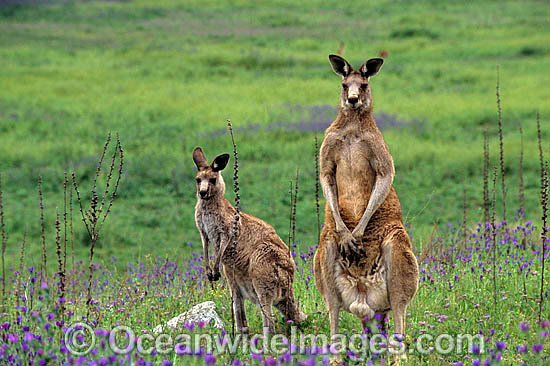On this post, Jane from Ohio asked if my picture was of kangaroos or wallabies.

I know a lot readers are not from Australia, and perhaps some that are might like a refresher, so Ranger Ingi presents: "The difference between Kangaroos and Wallabies"!!
The macropods in question are, in fact, kangaroos. Their scientific name is Macropus giganteus and they are more commonly known as Eastern Grey Kangaroos. Skippy was an Eastern Grey. Their distribution is basically the east coast of Australia:
They live in woodland, but eat grass - which explains why they occur in semi-urban areas. Despite popular media, you don't usually see kangaroos as you drive down the street, however on the south coast near where I live, they do come out of an evening and you have to be careful at dusk as they can jump out in front of your car, doing lots of damage to the car and to themselves.
You do have to be careful with approaching them in the wild (the photos above were taken at a wildlife park) as the males (significantly larger than the females) will defend their families quite violently. So it's best not to approach them and just take photos.
 |
| The male is much larger than the female |
Most of our furry animals in Australia are marsupials (giving birth to under-developed young, with females having some form of a pouch), and kangaroos and wallabies belong to the family Macropodidae, which also include tree-kangaroos and potoroos. Species known as "kangaroos" generally have a hind foot larger than 250mm - it is an arbitary distinction, rather than one based on other characteristics.
In our area we do also have wallabies, which are the species which are smaller than kangaroos. The most common on the south coast is the Swamp Wallaby (Wallabia bicolor) and is also sometimes (incorrectly) known as a Pademelon. It is a beautiful creature, with distinctive facial markings and is quite shy. Max loves to chase them when we visit our friends, who live in a more bushy area (if only we would let him off the lead).

Given that macropods co-exist near urban areas and in campgrounds in our National Parks, it is also important to remember that they should not be fed "human food" as their digestive systems are not equipped for it and it can lead to lumpy jaw disease.
I think it would be easy to become a bit blasé about our unique wildlife, but they never cease to amaze and fascinate me. It is a privilege to be able to observe them in their natural habitat and also to share information that will ensure their survival and health.






Amazing. And quite informative. You have amazing creatures there!
ReplyDeleteWell I learned something new Miss Ingi! I would have called it a Pademelon for sure. Thats what the parks around here call them. I wonder then, where did that name come from? I am going to have to go a searching now. Thanks lovely! Always nice to learn something new each day. :-) We are doing projects on icebergs today.
ReplyDeleteThank you very much. I was afraid that was yet another "doesn't she know anything about Australia" question.
ReplyDelete